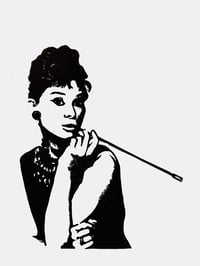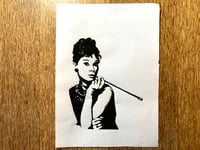Audrey Hepburn (Linocut Print)
SAVE £15!
NOW £25, WAS £40!
Audrey Hepburn is best known for being one of Hollywood’s most iconic actresses and, later on, for her humanitarian work with UNICEF. But her childhood was the stuff of Hollywood movies, and in many ways I’m surprised that her own story has not yet been put on the silver screen...
Audrey Hepburn was born in Belgium on 4th May 1929, but had dual British/Belgian nationality and lived her early years in England. She came from an affluent background - the daughter of a Dutch Baroness and a British/Austrian father. In the 1930s, Audrey’s father became very involved with the growing British Fascist movement, and he left the family when Audrey was only six - an experience that devastated her.
In 1939, with the outbreak of the war, her mother decided to move to the neutrality of The Netherlands. This proved to be a bad decision, because the following year the Nazis invaded. Initially, Audrey continued to attend school and learn ballet at the Arnhem Conservatory - something for which she had a promising future ahead. But life rapidly became more difficult. Audrey’s uncle was executed, her brother was taken to a labour camp for his resistance activities, and her other brother went into hiding for the same reason. Audrey herself was involved with the resistance, delivering food and messages, and helping at the hospital; her family even hid an Allied paratrooper. She also witnessed numerous Dutch Jews being transported to concentration camps, later stating that "more than once I was at the station seeing trainloads of Jews being transported, seeing all these faces over the top of the wagon.”
After D-Day, conditions grew worse, and Arnhem was subsequently heavily damaged during Operation Market Garden. During the Dutch famine that followed in the winter of 1944, the Germans blocked the resupply routes of the Dutch people's already limited food and fuel supplies. As with their neighbours, Hepburn's family resorted to making flour out of tulip bulbs, which are poisonous. She suffered from acute anaemia, respiratory problems and oedema, and severe malnutrition - possibly contributing to her waif-like appearance as an adult.
After the war Audrey pursued her dream of becoming a prima-ballerina, first in Amsterdam and then London, where she received a scholarship. She supported herself by doing a little modelling work, but it became apparent that the after-effects of her wartime malnutrition would mean that she would never attain the level she dreamed of. She thus decided to focus on acting - and the rest, as they say, is history!
In 1988, Audrey became a special Goodwill Ambassador to the United Nations UNICEF fund helping children in Latin America and Africa, a position she devoted the rest of her life to. Perhaps her own childhood led her to particularly empathise with their plight?
Audrey Hepburn died on 20th January 1993 from appendicular cancer, aged only 63. Her cinematographic career included 31 top movies and she was one of the most iconic characters in 20th century American cinema, setting new standards for glamour and fashion.
For this reason, I was inspired to depict Audrey as her character of Holly Golightly in the iconic movie, Breakfast at Tiffany’s, in response to the 2021 Printer Solstice prompt, ‘In Good Taste’. Filmed in 1961, Audrey received her third Academy Award nomination for this role, and it is without doubt the one for which she is most loved.
10% of each print sold will be donated to UNICEF.
ITEM SPECIFICS:
This image is a signed, hand carved and hand-pressed print on two different types of paper, as detailed below. It is limited to only 50 editions per paper type. As with all handmade items, each one will vary slightly making it completely unique.
It is printed with black water-based ink on a choice of two different papers:
1. Option 1 is Sunome Senaka, a white, fine 52gsm Japanese printmaking paper approximately 400x275mm in size.
(Pictures 1 & 2)
2. Option 2 is Fabriano Tiepolo; a 130gsm cream, 100% cotton acid free, PH neutral paper that is resistant to ageing. It’s printed on paper approximately 250x350mm in size.
(Pictures 3 & 4)
When choosing, it depends what’s more important to you personally. I would say the finer white paper in Option 1 gives better definition to the print, whereas the heavier cream version in Option 2 is more tactile and softer, better quality paper, but the image is a tad less crisp.
The image itself measures roughly 140x180mm.



